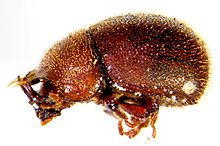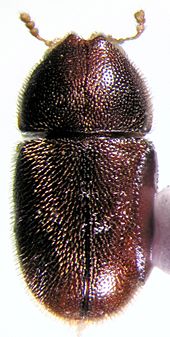- Ciidae
-
Ciidae 
Falsocis brasiliensis Scientific classification Kingdom: Animalia Phylum: Arthropoda Class: Insecta Order: Coleoptera Superfamily: Tenebrionoidea Family: Ciidae
Leach in Samouelle, 1819Subfamilies - Ciinae
- Orophiinae
- Sphindociinae (disputed)
Synonyms - Cioidae
- Cisidae
- Cissidae
The minute tree-fungus beetles, family Ciidae, are a sizeable group of beetles which inhabit Polyporales bracket fungi or coarse woody debris[verification needed]. Most numerous in warmer regions, they are nonetheless widespread and a considerable number of species occur as far polewards as Scandinavia for example.
Contents
Description
As their name implies, minute tree-fungus beetles are tiny, about 0.5 to 5 mm long. Their body is short and cylindrical, often convex, sometimes with a smooth coat of fine short hairs, sometimes being covered in long bristly hairs. They are mostly dark brown or blackish. The short antennae consist of 8–10 segments. The pronotum is wider than long and often forming a quite prominent helmet-like structure. The elytra do not taper noticeably over most of their length. The legs are short, the tibiae of the forelegs often beat characteristic extensions at the ends.
Ecology
These beetles usually inhabit Polyporaceae or more rarely Corticiaceae bracket fungi. The larvae as well as the adults burrow inside the fungi, often choosing old specimens or old tissue. The whole development, from egg to adult, often takes as little as two months; some are parthenogenetic. A few species are pest of commercial fungi, as the case of Cis chinensis, which infests dried fruiting-bodies of Ganoderma lucidum.
At least one ciid, Falsocis brasiliensis, is a threatened species. It occurs only in small forest remnants of the Northeast and Southeast Regions of Brazil.
Minute tree-fungus beetles are food for many predatory insects, like rove beetles (Staphylinidae), checkered beetles (Cleridae) and parasitoid wasp larvae.
List of genera
- Acanthocis Miyatake, 1954
- Anoplocis Kawanabe, 1996
- Apterocis Perkins, 1900
- Atlantocis Israelson, 1985
- Ceracis Mellié, 1849
- Cis Latreille, 1796
- Cisarthron Reitter, 1885
- Dichodontocis Kawanabe, 1994
- Dimerapterocis Scott, 1926
- Diphyllocis Reitter, 1885
- Dolichocis Dury, 1919
- Ennearthron Mellié, 1847
- Euxestocis Miyatake, 1954
- Falsocis Pic, 1916
- Hadraule Thomson, 1859
- Hyalocis Kawanabe, 1993
- Lipopterocis Miyatake, 1954
- Malacocis Gorham, 1886
- Neoapterocis Lopes-Andrade, 2007
- Neoennearthron Miyatake, 1954
- Nipponapterocis Miyatake, 1954
- Nipponocis Nobuchi & Wada, 1955
- Octotemnus Mellié, 1847
- Odontocis Nakane & Nobuchi, 1955
- Orthocis Casey, 1898
- Paratrichapus Scott, 1926
- Paraxestocis Miyatake, 1954
- Phellinocis Lopes-Andrade & Lawrence, 2005
- Plesiocis Casey, 1898
- Polynesicis Zimmerman, 1938
- Porculus Lawrence, 1987
- Rhopalodontus Mellié, 1847
- Scolytocis Blair, 1928
- Sphindocis Fall, 1917
- Strigocis Dury, 1917
- Sulcacis Dury, 1917
- Syncosmetus Sharp, 1891
- Trichapus Friedenreich, 1881
- Tropicis Scott, 1926
- Wagaicis Lohse, 1964
- Xylographella Miyatake, 1985
- Xylographus Mellié, 1847
References
- This article draws heavily on the corresponding article in the Dano-Norwegian-language Wikipedia.
- Gumier-Costa, F., Lopes-Andrade, C. & Zacaro, A. A. 2003. Association of Ceracis cornifer (Mellié) (Coleoptera: Ciidae) with the bracket fungi Pycnoporus sanguineus (Basidiomycetes: Polyporaceae). Neotropical Entomology, 32(2): 359–360.[1]
- Lawrence, J. F. 1987. A new genus of Ciidae (Coleoptera, Tenebrionoidea) from the Neotropical region. Revista Brasileira de Entomologia, 31(1): 41–47.
- Lawrence, J. F. 1991. Three new Asiatic Ciidae (Coleoptera: Tenebrionoidea) associated with commercial, dried fungi. The Coleopterists Bulletin, 45: 286-292.
- Lawrence, J. F. ; Lopes-Andrade, C. 2008. Ciidae Species Listing. Joel Hallan's Biology Catalog, Online[2]
- Lopes-Andrade, C. 2007a. Neoapterocis, a new genus of apterous Ciidae (Coleoptera: Tenebrionoidea) from Chile and Mexico. Zootaxa, 1481: 35-47.
- Lopes-Andrade, C. 2007b. Notes on Falsocis Pic (Coleoptera: Tenebrionoidea: Ciidae), with the description of an endangered Brazilian species. Zootaxa, 1544: 41-58.
- Lopes-Andrade, C. 2008 The first record of Cis chinensis Lawrence from Brazil, with the delimitation of the Cis multidentatus species-group (Coleoptera: Ciidae). Zootaxa, 1755: 35-46.
- Lopes-Andrade, C., Gumier-Costa, F. & Sperber, C. F. (2003) Why do male Xylographus contractus Mellié (Coleoptera: Ciidae) present abdominal fovea? Evidence of sexual pheromone secretion. Neotropical Entomology, 32: 217-220.[3]
- Lopes-Andrade, C., Gumier-Costa, F., Zacaro, A.A. 2003. Cis leoi, a new species of Ciidae (Coleoptera: Tenebrionoidea) from the Neotropical Region. Zootaxa, 161: 1–7.
- Lopes-Andrade, C., Madureira, M. S., Zacaro, A. A. 2002. Delimitation of the Ceracis singularis group (Coleoptera: Tenebrionoidea: Ciidae), with the description of a new Neotropical species. Dugesiana, 9: 59–63.
- Lopes-Andrade, C., Zacaro, A. A. 2003a. The first record of Ennearthron Mellié, 1848 (Coleoptera: Tenebrionoidea: Ciidae) in the Southern Hemisphere, with the description of a distinctive new species. Zootaxa, 395: 1–7.
- Lopes-Andrade, C., Zacaro, A. A. 2003b. Xylographus lucasi, a new Brazilian species of Ciidae (Coleoptera: Tenebrionoidea). Dugesiana, 10: 1–6.
- Lopes-Andrade, C. & Lawrence, J. F. 2005. Phellinocis, a new genus of Neotropical Ciidae (Coleoptera: Tenebrionoidea). Zootaxa, 1034: 43–60.
- Madenjian, J. J., Eifert, J. D. & Lawrence, J. F. 1993. Ciidae: newly recognized beetle pests of commercial dried mushrooms. Journal of Stored Products Research, 29: 45-48.
- Orledge, G. M., Reynolds, S. E. 2005. Fungivore host-use groups from cluster analysis: patterns of utilisation of fungal fruiting bodies by ciid beetles. Ecological Entomology, 30(6): 620–641.
- Ruta, R. 2003. Rhopalodontus lawrencei n. sp. – the first Rhopalodontus species in the Oriental Region. Genus, 14(3): 363–369.[4]
Categories:
Wikimedia Foundation. 2010.


